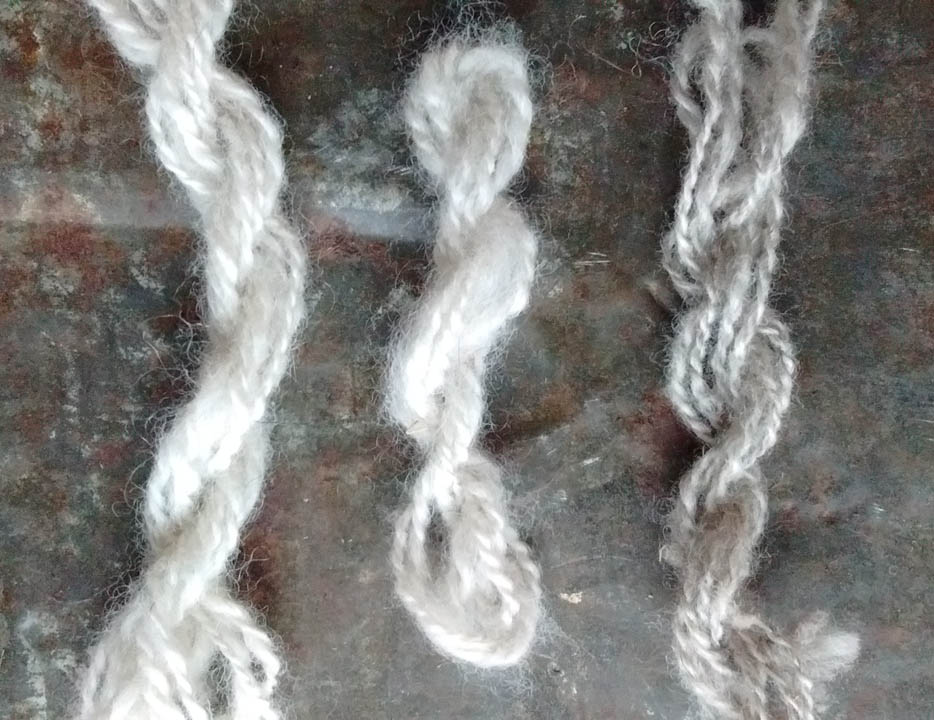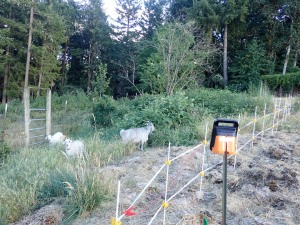This is how I rainbow dye. I use Landscape dyes (from Australia), but any dye could be used. I use this method to dye handspun cashmere plyed with a silk thread. The resulting yarn is 400 – 500 yds/oz, so it is very fine. I try to make the colors subtle enough so that it isn’t a distraction for lace-knitted items.
I dye outside using a single burner hot plate in order to avoid evil fumes (and mess) in the kitchen. First I soak the skeins to be dyed for 30 minutes in water with just a drop or two of dishwashing soap. Squeeze all the water you can out of the skeins.
In the dye pot, I use a base skein of some other yarn so the cashmere skeins are only partially covered in the dye bath. I call this the throw-away skein, but it also turns out pretty and usually sells quickly at shows. I use 2-yard skeins (because this is what comes off my niddy-noddy) and arrange them as shown in the pot on top of the base skein. If you have more than one skein, just layer them up. Add just enough water to partially cover the top skein. Using a small amount of dye mixed with water (about 1/2 tsp per cup of water with my dye) and pour some of it carefully onto the top skein. I use 3 colors on the outside sections of the skein path and another color in the center. The colors will mix in the cooking and how much dye you place on the skein, how much water in the pot and how vigorously the water boils will have an effect on the mix.
Gently simmer for however long your dye instructions tell you. I use 30-35 minutes for my dye. Don’t even think about stirring it or even poking it around in the bath! When done, wash it well with liquid dishsoap (I use Dawn) or whatever you generally use to wash wool. Rinse well and let dry.
There’s a lot of serendipity involved although in 15 different batches, I’ve only had one batch I considered a failure and that wasn’t because it was ugly; it just wasn’t a color combination that sold well. I eventually dyed over it with a couple other colors and it sold at the next show.
Knitting note: I like to use this yarn for lace knitting. Because of the silk thread for the 2nd ply, the lace has more definition to the stitches than 100% cashmere.
One more note: Originally I thought I got the idea for this from an old Woodland Woolworks flyer by Melda Montgomery, but after doing it for a while, I looked back at her flyer and find I don’t use anything from the flyer except how much dye powder to add to the water.





































 One of the seven wonders of the preserving world is Quince Jam (Preserves). It starts out as a beautiful, aromatic, inedible fruit. However, you can devote about 6 hours to it and turn it into something wonderful. Preserving books call is Quince Preserves. I call it Quince Jam. We have a small tree which lives in the temporary turkey pen and despite being roosted in by turkeys and occasionally nibbled on by goats, produces a bumper crop of quinces each year. This year was no different. To make the preserves, you peel and chunk up the creamy white quinces. You make a sugar syrup, add the chunks and then (patiently) boil it down for hours and hours. As the mixture boils down, it thickens and turn a lovely ruby shade.
One of the seven wonders of the preserving world is Quince Jam (Preserves). It starts out as a beautiful, aromatic, inedible fruit. However, you can devote about 6 hours to it and turn it into something wonderful. Preserving books call is Quince Preserves. I call it Quince Jam. We have a small tree which lives in the temporary turkey pen and despite being roosted in by turkeys and occasionally nibbled on by goats, produces a bumper crop of quinces each year. This year was no different. To make the preserves, you peel and chunk up the creamy white quinces. You make a sugar syrup, add the chunks and then (patiently) boil it down for hours and hours. As the mixture boils down, it thickens and turn a lovely ruby shade.



















